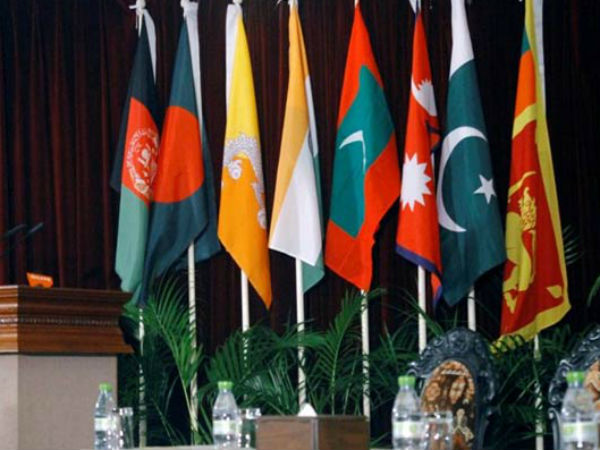‘SAARC’, which is an abbreviation of The South Asian Association for Regional Cooperation, is an organisation of South Asian countries, formed with a vision of collective progress by sharing economic, social and cultural values across the region.
The International organisation came into existence with the signing of the SAARC charter on December 8, 1985 in Dhaka, Bangladesh. Later its Secretariat was set up in Kathmandu on January 17, 1987 from where all its official work is regulated.

Member States of SAARC
SAARC is an organisation of 8 South Asian countries; Maldives, Sri Lanka, India, Pakistan, Afghanistan, Nepal, Bhutan and Bangladesh. Afghanistan bece the signatory of SAARC charter in 2007 and became its 8th member state. As Russia and Turkey have also applied for its membership, they might be added as the member States of SAARC in future.
Besides 8 member States there are 9 other observer countries joining SAARC conferences annually; China, the USA, Myanmar, Iran, Japan, South Korea, Australia, Mauritius and the European Union.
Headquarters of SAARC
The Headquarter of SAARC is situated in Kathmandu, Nepal which is headed by the Secretary General of SAARC. The 1st Secretary General was Mr Abul Ahsan from Bangladesh and in present the Secretariat is held by Mr Esala Ruwan Weerakoon from Sri Lanka who assumed the office on March 1, 2020.
Motto of SAARC
The motto for which the organisation works is, ‘Deeper Integration for Peace and Prosperity’.
SAARC is an intergovernmental organisation which is dedicated towards the integrated Economical and Regional and Political developments.
The SAARC Charter
The SAARC charter is a draft which comprises 10 articles briefing about various dimensions of this intergovernmental body. These articles define the objectives, principles, institutional and financial arrangements. So let’s know about it in detail.
Article 1: It defines the Objectives such as to promote the welfare and improve the quality of lives of people, economic, social and cultural development, strengthening of collective self-reliance and cooperation on International forums.
Article 2: It defines the Principles such as sovereign equality, territorial integrity, political Independence, non interference in the internal affairs of other states and mutual benefit.
Article 3: It briefs about the annual meetings of the heads of State or government twice a year.
Article 4: It constitutes a Council of foreign Ministers of member states for policy making, reviewing of progress and for important decisions making.
Article 5: It constitutes a standing committee of Foreign Secretaries for the approval and monitoring of programmes, determining inter-sectoral priorities, mobilisation of resources and to submit periodic reports to the council of Ministers.
Article 6: It briefs about the Technical Committee which will be responsible for the implementation, coordination and monitoring of the programmes in respective areas of cooperation.
Article 7: It briefs about the Action Committee comprising member States concerned with implementation of projects involving more than two but not all member states.
Article 8: Here is a provision about the Secretariat of association.
Article 9: This article talks about the Financial arrangements which will be volunteered by the member States.
Article 10: It provides other general provisions. As per article 10, decisions at all levels shall be taken on the basis of unanimity.
SAARC Summits
The meetings of Heads of member States of SAARC held twice a year, which are hosted by a member state in alphabetical order. Whosoever hosts the meeting, holds the chair of the Association. The main outcome of these meetings or Summits is declaration which contains decisions and directives of the leaders to strengthen regional cooperation.
The Secretary General and Heads of observer delegations also address the Summits.
The 18th SAARC Summit
The last summit was held as the 18th summit of SAARC which was held in 2014 and hosted by Nepal in Kathmandu. The 19th diplomatic conference got cancelled due to some reasons and now the 20th summit will be organised in 2022 which will be hosted by Pakistan at Islamabad.
The 18th summit concluded with a declaration which recognized the labour migration as an issue which needed collective action. Along with the collaboration to ensure the protection of migrant workers from South Asia, another issue was to prevent and tackle women and children trafficking for which the leaders of member states called for global authorities.
Structure of SAARC
There is a provision of two main bodies for SAARC.
- Council : It is an apex body indulged in policy making works. It is represented by government heads of the respective member countries.
- Council of Ministers : It is a body of Foreign Ministers of Member States who meet twice annually. It is to;
- Formulate Policies.
- Identify the New areas of corporation.
- Review the progress of Regional Cooperation.
Areas of Cooperation of SAARC
To fulfill the bilateral and multilateral interests of Member States, some generalized areas of cooperation are defined under the Charter. These areas are;
- Agriculture and rural development.
- Education, culture, biotechnology, science, energy and environment.
- Tourism, information, Communication and Media
- People to people contacts, funding mechanism.
- Security aspects, poverty alleviation, trade and finance.
Interesting Facts on SAARC
Here We are presenting some quick facts Important from exam point of view.
The official language of SAARC is English.
- Initially there were just 7 countries as member states of SAARC. During its 30th Summit held in New Delhi in April 2007, Afghanistan became the 8 member State.
- India has hosted SAARC Summit three times in 1986, 1995 and 2007.
- The SAARC satellite for South Asia was launched in 2017.
- In February 2011, Fathimath Dhiyana Saeed became the First woman elected as the Secretary General of SAARC.
- SAARC comprises 21% of the world population and 3.8% of the global economy.
- SAPTA: South Asia Preferential Trade Agreement was signed in 1995.